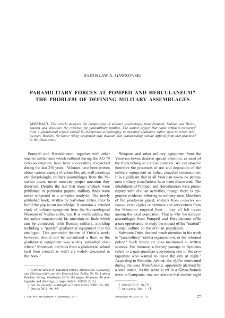- Search in all Repository
- Literature and maps
- Archeology
- Mills database
- Natural sciences
Advanced search
Advanced search
Advanced search
Advanced search
Advanced search

Object
Title: Paramilitary Forces at Pompeii and Herculaneum? The Problem of Defining Military Assemblages
Subtitle:
Publisher:
Place of publishing:
Description:
Type of object:
Abstract:
This article analyzes the composition of military assemblages from Pompeii, Stabiae and Herculaneum and discusses the evidence for paramilitary militias. The author argues that some artifacts recovered from a gladiatorial school should be interpreted as belonging to mounted gladiators rather than to urban militia men. Besides, the horse riding equipment may indicate that Italian riding culture differed from that practiced in the limes zone
References:
Bisel, S.C. and J.F. Bisel. 2002. “Health and Nutrition at Herculaneum.An Examination of Human Skeletal Remains,” in: W.F. Jashemski and F.G. Meyer (eds.), The Natural History of Pompeii, Cambridge, 451– 475
Bishop, M.C. 1988. “Cavalry equipment of the Roman army in the first century AD,” in: J.C.N. Coulston (ed.), Military Equipment and the Identity of the Roman Soldiers, Proceedings of the Fourth Roman Military Equipment Conference, BAR International Series 394, Oxford, 67–195
Brouwer, M. 1982. “Römische Phalerae und anderer Lederbeschlag aus dem Rhein,” Oudheidkundige Mededeelingen uit het Rijksmuseum van Oudheden te Leiden 63, 145–199
Campbell, V.L. 2015. The Tombs of Pompeii: Organization, Space, and Society, New York
Connolly, P. 1998. Greece and Rome at War, London
D’Amato, R. and R. Ruggieri (il.). 2016. Roman Army Units in the Western Provinces (1) 31 BC – AD 195, Oxford
D’Amato, R. and G. Sumner (il.). 2009a. Arms and Armour of the Imperial Roman Soldier, from Marius to Commodus 112 BC – AD 192, London
D’Amato, R. and G. Sumner (il.). 2009b. Imperial Roman Naval Forces 31 BC – AD 500, Oxford
Deschler-Erb, E. 1999. Ad arma!: Römisches Militär des 1. Jahrhunderts n. Chr. in Augusta Raurica, Augst
Fischer, T. 2012. Die Armee der Caesaren: Archäologie und Geschichte. Gebundene Ausgabe, Regensburg
Hyland, A. 1993. Training the Roman Cavalry, Stroud
James, S. 2004. Excavations at Dura Europos 1928 –1937: Final Report VII: The Arms and Armour and Other Military Equipment, London
James, S. 2011. Rome: the Sword. How Warriors and Weapons Shaped Roman History, London
Jenkins, I. 1985. “A Group of Silvered-Bronze Horse Trappings from Xanten (Castra Vetera),” Britannia 16(2), 141–164
Junkelmann, M. 1990. Die Reiter Roms, Teil I: Reise, Jagd, Triumph und Circusrennen, Mainz
Junkelmann, M. 1996. Reiter wie Statuen aus Erz, Mainz
Junkelmann, M. 2000. Das Spiel mit dem Tod. So kämpften Roms Gladiatoren, Mainz
Junkelmann, M. 2004. Römische Helme. Sammlung Axel Guttmann, Mainz
Nicolay, J. 2001. “Interpreting Roman military equipment and horse gear from non-military contexts: the role of veterans,” Gesellschaft pro Vindonissa, Jahresbericht 2001, 53– 66
Ortisi, S. 2015. Militärische Ausrüstung und Pferdegeschirr aus den Vesuvstädten, Palilia 29, Wiesbaden
Rabeisen, E. 1990. “La production d’équipement de cavalerie au 1er s. après J.C. à Alesia (Alise-Sainte-Reine, Côte-d’Or, France),” Journal of Roman Military Equipment Studies 1, 73–98
Rankov, B. and R. Hook (il.). 2002. The Praetorian Guard, Oxford
Sekunda, N. and A. McBride (il.). 1996. Republican Roman Army 200 –104 B.C., Oxford
Sumner, G. 2002. Roman Military Clothing (1) 100 BC – AD 200, Oxford
Relation:
Volume:
Start page:
End page:
Detailed Resource Type:
Format:
Resource Identifier:
oai:rcin.org.pl:87275 ; 0066-605X
Source:
IAiE PAN, call no. P III 24 ; IAiE PAN, call no. P III 29 ; IAiE PAN, call no. P III 30 ; click here to follow the link
Language:
Rights:
Rights Reserved - Restricted Access
Terms of use:
Digitizing institution:
Institute of Archaeology and Ethnology of the Polish Academy of Sciences
Original in:
Library of the Institute of Archaeology and Ethnology of the Polish Academy of Sciences
Access:
Object collections:
- Digital Repository of Scientific Institutes > Partners' collections > Institute of Archeology and Ethnology PAS > Institute Publications
- Digital Repository of Scientific Institutes > Partners' collections > Institute of Archeology and Ethnology PAS > Institute Publications > Current Journals
- Digital Repository of Scientific Institutes > Literature > Journals/Articles
- Digital Repository of Scientific Institutes > Partners' collections > Institute of Archeology and Ethnology PAS > Institute Publications > Current Journals > Archeologia
Last modified:
Apr 9, 2021
In our library since:
Dec 8, 2019
Number of object content downloads / hits:
10
All available object's versions:
https://rcin.org.pl./publication/85833
Show description in RDF format:
Show description in RDFa format:
Show description in OAI-PMH format:
Objects Similar
Weichardt, Carl Friedrich Wilhelm (1846–1906)
Chowaniec, Roksana
Stelmachowska, Bożena (1889–1956)
Gurba, Jan Ślusarski, Zygmunt
Jamka, Rudolf (1906–1972)

 INSTYTUT ARCHEOLOGII I ETNOLOGII POLSKIEJ AKADEMII NAUK
INSTYTUT ARCHEOLOGII I ETNOLOGII POLSKIEJ AKADEMII NAUK
 INSTYTUT BADAŃ LITERACKICH POLSKIEJ AKADEMII NAUK
INSTYTUT BADAŃ LITERACKICH POLSKIEJ AKADEMII NAUK
 INSTYTUT BADAWCZY LEŚNICTWA
INSTYTUT BADAWCZY LEŚNICTWA
 INSTYTUT BIOLOGII DOŚWIADCZALNEJ IM. MARCELEGO NENCKIEGO POLSKIEJ AKADEMII NAUK
INSTYTUT BIOLOGII DOŚWIADCZALNEJ IM. MARCELEGO NENCKIEGO POLSKIEJ AKADEMII NAUK
 INSTYTUT BIOLOGII SSAKÓW POLSKIEJ AKADEMII NAUK
INSTYTUT BIOLOGII SSAKÓW POLSKIEJ AKADEMII NAUK
 INSTYTUT CHEMII FIZYCZNEJ PAN
INSTYTUT CHEMII FIZYCZNEJ PAN
 INSTYTUT CHEMII ORGANICZNEJ PAN
INSTYTUT CHEMII ORGANICZNEJ PAN
 INSTYTUT FILOZOFII I SOCJOLOGII PAN
INSTYTUT FILOZOFII I SOCJOLOGII PAN
 INSTYTUT GEOGRAFII I PRZESTRZENNEGO ZAGOSPODAROWANIA PAN
INSTYTUT GEOGRAFII I PRZESTRZENNEGO ZAGOSPODAROWANIA PAN
 INSTYTUT HISTORII im. TADEUSZA MANTEUFFLA POLSKIEJ AKADEMII NAUK
INSTYTUT HISTORII im. TADEUSZA MANTEUFFLA POLSKIEJ AKADEMII NAUK
 INSTYTUT JĘZYKA POLSKIEGO POLSKIEJ AKADEMII NAUK
INSTYTUT JĘZYKA POLSKIEGO POLSKIEJ AKADEMII NAUK
 INSTYTUT MATEMATYCZNY PAN
INSTYTUT MATEMATYCZNY PAN
 INSTYTUT MEDYCYNY DOŚWIADCZALNEJ I KLINICZNEJ IM.MIROSŁAWA MOSSAKOWSKIEGO POLSKIEJ AKADEMII NAUK
INSTYTUT MEDYCYNY DOŚWIADCZALNEJ I KLINICZNEJ IM.MIROSŁAWA MOSSAKOWSKIEGO POLSKIEJ AKADEMII NAUK
 INSTYTUT PODSTAWOWYCH PROBLEMÓW TECHNIKI PAN
INSTYTUT PODSTAWOWYCH PROBLEMÓW TECHNIKI PAN
 INSTYTUT SLAWISTYKI PAN
INSTYTUT SLAWISTYKI PAN
 SIEĆ BADAWCZA ŁUKASIEWICZ - INSTYTUT TECHNOLOGII MATERIAŁÓW ELEKTRONICZNYCH
SIEĆ BADAWCZA ŁUKASIEWICZ - INSTYTUT TECHNOLOGII MATERIAŁÓW ELEKTRONICZNYCH
 MUZEUM I INSTYTUT ZOOLOGII POLSKIEJ AKADEMII NAUK
MUZEUM I INSTYTUT ZOOLOGII POLSKIEJ AKADEMII NAUK
 INSTYTUT BADAŃ SYSTEMOWYCH PAN
INSTYTUT BADAŃ SYSTEMOWYCH PAN
 INSTYTUT BOTANIKI IM. WŁADYSŁAWA SZAFERA POLSKIEJ AKADEMII NAUK
INSTYTUT BOTANIKI IM. WŁADYSŁAWA SZAFERA POLSKIEJ AKADEMII NAUK




































